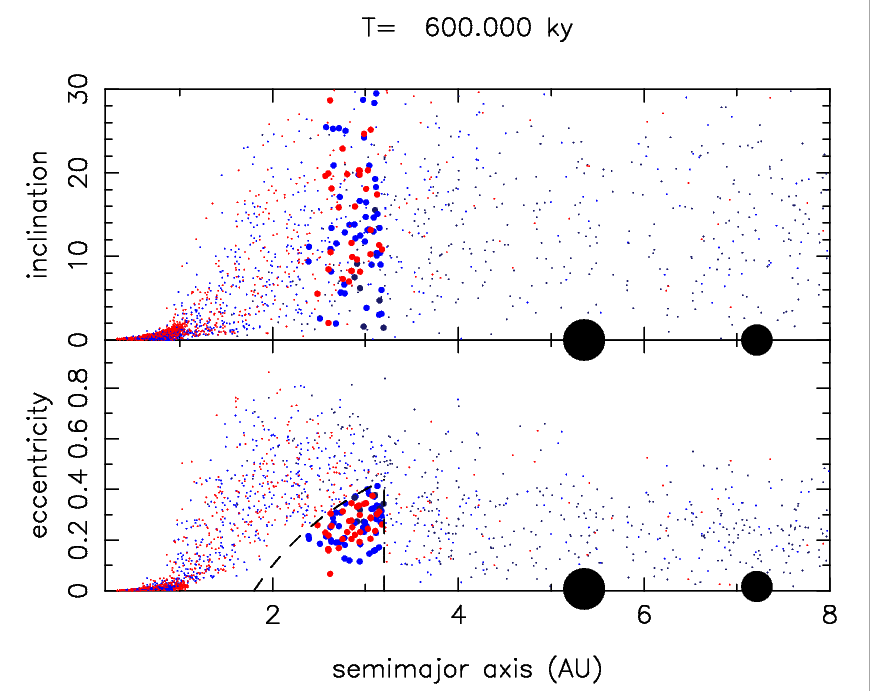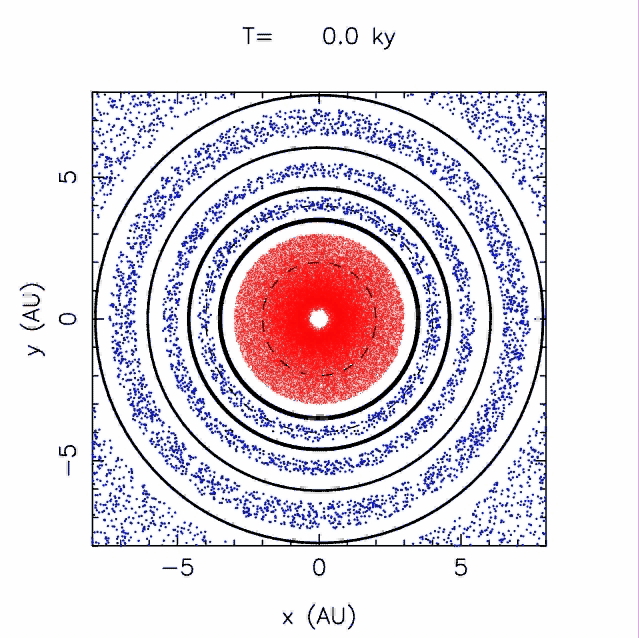The Grand Tack
The Grand Tack is a scenario for early inner Solar System evolution, published in 2011 in the journal Nature ([arXiv]). This project has possible implications for many aspects of planetary science, and therefore we have prepared a longer description with more details than are typically available in a relatively short publication. This task is in progress, so I apologize if it is short on details right now.
Updates:
-- Obrien et al. is submitted - this work covers the dynamical implications of the terrestrial planet formation in the Grand Tack, focusing specifically on water delivery via the primitive planetesimals.
-- A proceedings from "Workshop on Formation of the First Solids in the Solar System" was published in MAPS in December 2012 [MAPS][PDF]. This is more of a review, focused on the chronological and physical implications for the asteroid belt and how the Grand Tack provides initial conditions for the Nice Model, which is proposed to happen 500 Myr later (around 4 billion years ago).
-- A review by Morby in Annular Review of Earth and Planetary Science was published in 2012 [PDF]
-- Sean Raymond and Arnaud Pierens studied the hydrodynamics of the inward-then-outward migration of Jupiter and Saturn [ADS].
-- Sean Raymond and Arnaud Pierens did more work on the migration of Jupiter and Saturn [arXiv]
Press:
SwRI Press Release. NASA Press Release. Sky and Telescope. NBC News. Recently mentioned in relation to study of water on the Moon.
2013- Comet ISON special on Horizon, BBC.
2014- Planet formation special on Horizon, BBC [just filmed - out Spring 2014 - lots of ice-skating action scenes...].
2014- Discovery Channel Series "How the Universe Work" [Spring 2014].
Background, Chronology and the Nice Model
In the last few decades we have learned that planets have the capability to move around - their orbits are not static. While the discovery of interesting planets around other stars really demand dramatic migration effects (Hot Jupiters for example), we now find signs all over our own Solar System that point to sometimes violent migration of our own planets. Understanding when and how our own planets migrate is a major goal of dynamicist studying the formation and evolution of our Solar System. We know of three major types of planetary migration: gas migration, planetesimal scattering migration and planet-planet scattering.
Gas Migration:After a star forms a disk of gas survives around for for a few (1-10) million years. The disk of gas far outweighs the total amount of solid material that could form, and thus given the right conditions can push planets rapidly and great distances. There are a handful of studied types of gas migration, each of which depend on many hard to study parameters, such as the viscosity of the gas or the temperature gradients in the disk. However, knowing that gas is required fundamentally restricts these modes of migration to the earliest 1-10 million years of a Star's lifetime. For context, in our own Solar System it is thought that the giant planets formed in a few million years (before the gas disk dissipateed), while the terrestrial planets took 10-100 million years to form.
Planetesimal Scattering Migration:In some scenarios, including our own Solar System, it is thought that there are regions where large disks of small planetesimals (km to 100s of km size objects) form rather than a few large planets. These smaller bodies can easily be tossed around the Solar System if they come into contact with a planet (Jupiter easily scattering an asteroid out of the Solar System). Each time a planet scatters a smaller planetesimal there is an exchange of angular momentum, which given enough encounters with small bodies can change the orbit of the planet in a significant way. This is called planetesimal scattering migration, and is thought to have played a major role in the evolution of Neptune. This type of migration can happen any time in the history of a Solar System, as long as there remains a sizeable population of small bodies -- for example the today's asteroid belt would not nearly be massive enough to move any planets.
Planet-Planet ScatteringFinally, the most dramatic events in a Solar System's history happens when planets end up on crossing orbits. In these cases planets orbits can become very eccentric (elongate) and they can excite and remove otherwise stable resevoirs of planetesimals and planets in a Solar System. These instabilities are thought to have numerous causes, distant stellar companion (Kaib et al. 2013), long-term interactions with massive disks of planetesimals (Levison et al. 2011) or simply inheritly unstable and chaotic orbits. It is generally thought that most instabilities happen
The Chronology of our Solar System: An important piece of scientific data from the Apollo missions was radiometric dates for major impacts events on the Moon. With no atmosphere to erode away impact histories, the lunar surface can report on most of the history of the Solar System. The data from those missions, and also from lunar meteorites (chunks of the Moon liberated during impacts that eventually hit the Earth), suggest that the Moon (and therefore the Earth) suffered a surge of impacts around 4 billion years ago. This bombardment is relatively "late" in the history of the Solar System, as nearly 600 million years would have passed from its formation 4.56 billion years ago, before this "late heavy bombardment" (LHB) would have taken place. Such an impact spike is hard to explain in a quiescent and stable Solar System. This LHB has been linked to an instability and episode of planet-planet scattering among our giant planets -- commonly referred to as the "Nice Model" (Tsiganis et al. 2005, Gomes et al. 2005, Levison et al. 2011). This instability has been used to explain numerous properties of the Solar System (Jupiter's Trojans, Irregular Satellites, the structure of the Kuiper Belt etc.), and its violent nature makes it a viable and attractive cause of the LHB.
The first few million years: Thus planetary migration by way of planet-planet scattering (and also planetesimal scattering migration of Neptune) is thought to be responsible for the final re-shaping of our Solar System 4 billion years ago. However, there are many problems with our understanding of the inner Solar System that may be explained with earlier gas-migration of our planets. Given the relatively short lifetime of the gaseous disk around our Sun, these events are restricted to the first few million years of our Solar System's lifetime, but the power of gas migration to push giant planets large distances rapidly makes for significant consequences.
The small Mars problem
|
Many have searched for a solution to the "Mars Problem." This problem
is essentially the inability of modern computer simulations of
terrestrial planet formation to create correct-size Mars
analogs at the location, 1.5 AU, where we find Mars today. Typically the Mars-analogs are produced at 0.5 to 1.0 the
mass of the Earth - much larger than its actual mass at 0.1 times the
mass of the Earth. The figure to the right shows a plot from Raymond et
al. 2009 with the actual planets as the filled squares (with Mars
at 1.5 AU), and the results from many simulations plotted as gray
circles. At the location of Mars, the planets being formed in the
simulations are 5-10 times too massive. |
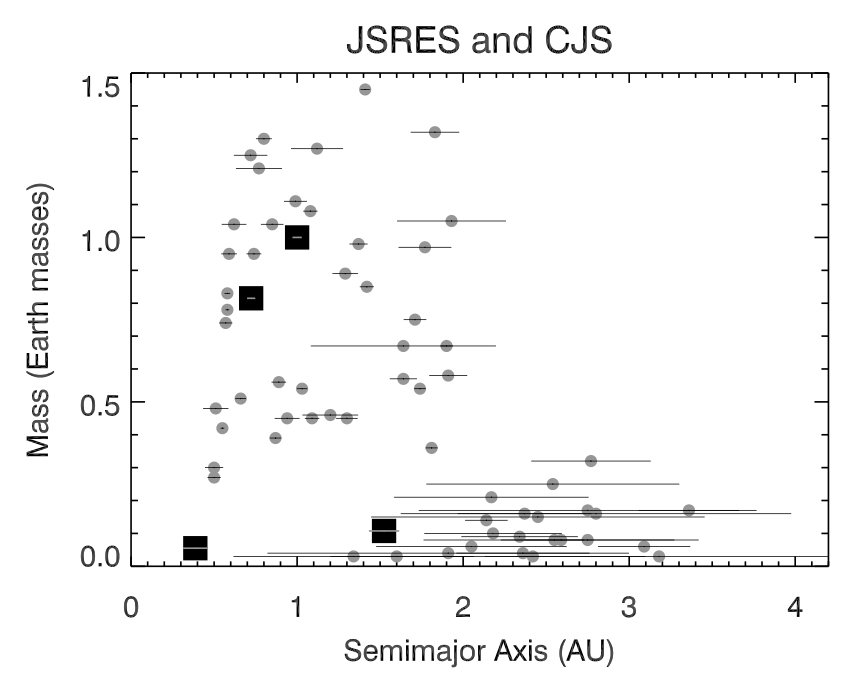 |
|
The previous struggles with this problem consistently point to a need to change the surface density of the proto-solar disk very early, before Mars accretes too much material. A test of this idea was put forth by Hansen 2009, who showed that the mass and semi-major axis properties of the terrestrial planets could be reproduced very nicely if the planets formed from a narrow annulus of material located between 0.7-1.0 AU (see Figure to the right, showing the simulated planets around 1.5 AU are similar in mass to Mars, which is shown as a filled dot). This is in stark contrast to typical models that have a smooth distribution of material from 0.5 or 0.7 AU out to the formation region of Jupiter (3-5 AU typically). Thus if the planetesimal disk was truncated at 1.0 AU very early, the small-Mars problem could be solved. |
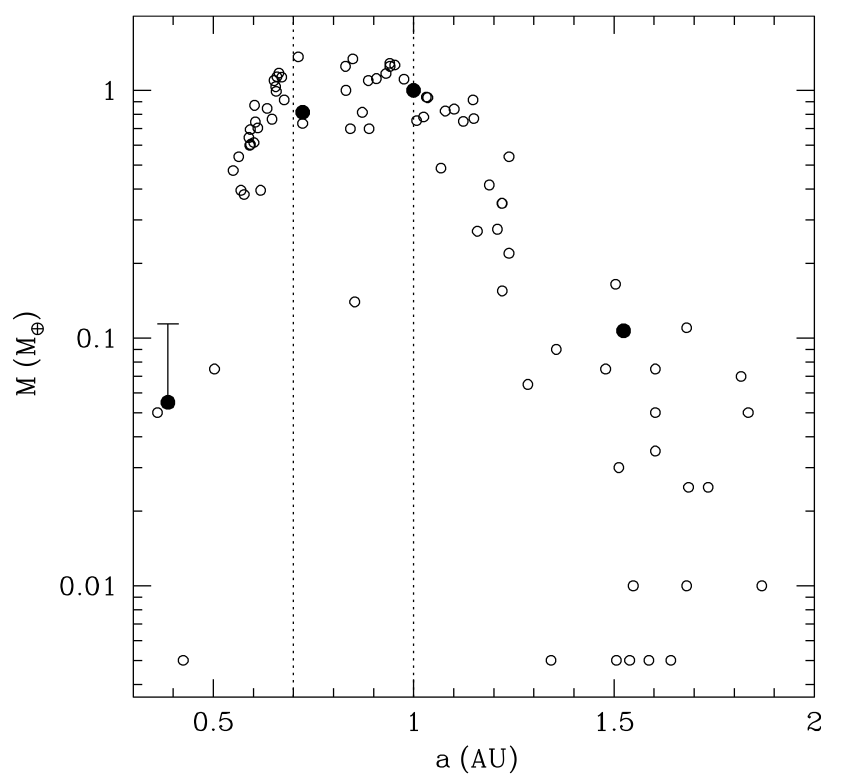 |
|
The "Grand Tack" aims to explain the truncation of the planetesimal disk at 1.0 AU by way of the migration of the Giant Planets. We model the effects on the inner Solar System caused by the inward, then outward, migration of Jupiter. This mode of migration was observed in numerous hydrodynamic simulations of Jupiter- and Saturn-mass planets in a gas-disk (see Masset & Snellgrove 2001 or Pierens & Raymond 2011, and also see d'Angelo and Marzari 2012). A priori, given the vast uncertainties in disk evolution and giant planet formation, we cannot know where a "tack" of Jupiter may have occured. However, if Jupiter migrates inward and "tacks" at 1.5 AU, the inner disk is truncated around 1 AU, reproducing the intial conditions from Hansen 2009 which produced ideal Mars/Earth mass ratios. This scenario is shown in the cartoon on the right, and simulations of the behavior found in hydrodynamic models was then taken and imposed for N-body gravity simulations to observe the global outcome for the small body populations - especially focused on the Asteroid Belt. |
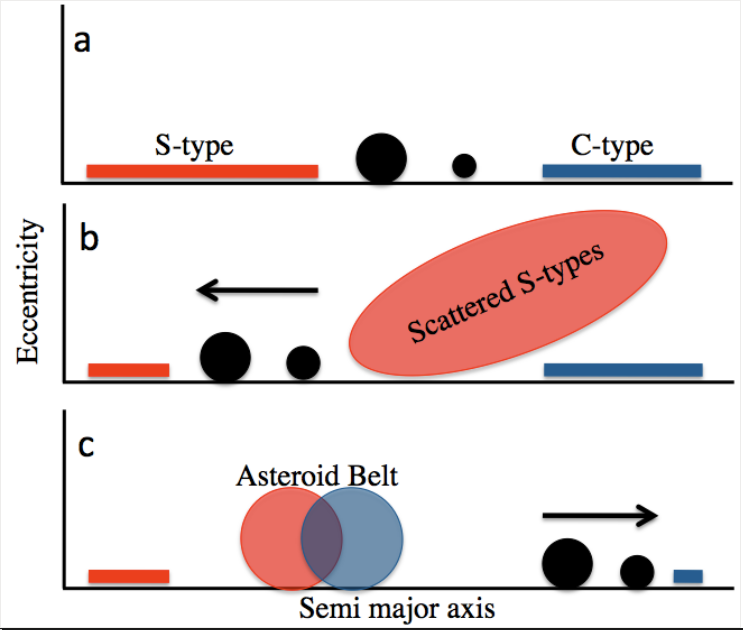 |

